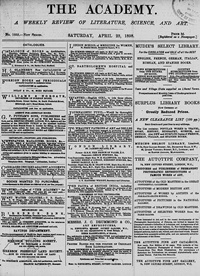 The Academy (London, UK)
The Academy (London, UK)
- An Observer in Malay (Apr 23, 1898)

23 April 1898
In April 1898, Conrad was approached by Hind for a review of Hugh Clifford's Studies in Brown Humanity (1898). The Academy did not normally publish the names of its reviewers, but, in accepting the commission, Conrad outlined his reasons for wishing to be credited with a byline: '[I]t is the high standing and the intellectual authority of the publication which gives its final value to the criticism appearing in its pages. And it is this conviction which induced me to avail myself of your offer. Yet it seems to me that fundamentally, in the matter of criticism it is always the individual voice that speaks and, if so, then the individual should not be hidden' (CL 2:58). Later, he would claim to have 'stipulated for my signature' (CL 2:181), and refer slightingly to The Academy as a 'preposterous weekly' (CL 2:411).
The Academy was influential in establishing Conrad's early reputation as 'a novelist's novelist' (10 Nov 1900), and announced: 'Mr Conrad . . . is one of the notable literary colonists. He has annexed the Malay Peninsula for us' (14 January 1899). Its reviewers described Almayer's Folly as 'leav[ing] an impression of grasp and power' (15 June 1895) and Typhoon as 'distinct achievement [before which] criticism may well lay down its arms' (9 May 1903). In January 1899, Conrad received a prize of '50 from The Academy for 'Youth' and his collection of short stories Tales of Unrest.
A particularly important reviewer at The Academy was Conrad's friend Edward Garnett, to whom he dedicated The Nigger of the 'Narcissus'. Although Israel Zangwill complained that the novel had 'no plot and no petticoats' (1 January 1898) -- a 'bad' review, noted Conrad (CL 2:9) -- Garnett called it a 'masterpiece' in his appreciative article on Conrad which also appeared in The Academy later that year (15 October 1898). The touched-up accompanying photograph drew Conrad's irony: 'in The Academy photograph it is not my clothes that are endimanches [Sunday best] but my face' (CL 2:105). Yet there was nothing ironic about his efforts to secure the periodical's endorsement of The Rescue, at this point scheduled to appear in The Illustrated London News: 'Perhaps I could work The Academy. Ask Garnett first and then set [E.V.] Lucas (one of The Academy gang) to work the oracle within the temple [i.e. Hind], so as to get the book sent to Garnett?' (CL 2:122). Garnett may also have written the unsigned review of Lord Jim in The Academy (10 November 1900), which criticized the novel as being implausibly long for an after-dinner story; in his 1917 'Author's Note' to the novel Conrad offered a defense of his method. The publication of Youth and Other Stories, declared Garnett in The Academy, was 'one of the literary events of the year' (6 December 1902).
Publication details
Published in London. Price 3d. Issues: 9 Oct 1869-Aug 1916. Articles were signed but most reviews were not. Publishers: John Murray (Oct 1869-Sept 1870); Williams & Norgate (Oct 1870-Dec 1873); Academy (Jan 1874-Mar 1905); Country Life (Mar 1905-Mar 1907); H.E. Morgan (Mar 1907-Mar 1908); Odhams (Mar 1908-Dec 1911). Editors: Charles Appleton (1869-1878); Charles Doble (1878-1880); James S. Cotton (1881-1896); Charles L. Hind (1896-1903); William Teignmouth Shore (1903-1904); Graham & Child (1905-1906); Lord Alfred Douglas (1907-1910); Cecil Cowper (1910-1915); Henry Savage (1915); T.W.H. Crosland (1916). Frequency: monthly (Oct 1869-Dec 1870); fortnightly (Jan 1871-Dec 1873); weekly (Jan 1874-Sept 1915); monthly (Oct-Dec 1915); irregular (Jan-Aug 1916, plus three revived issues on 12 May, 17 June, and July/Aug 1916).
Sources
Davies, Laurence, et al., ed. The Collected Letters of Joseph Conrad. Cambridge: Cambridge University Press, 1983-2007. 9 vols.
Dryden, Linda. 'Conrad and Hugh Clifford: An "Irreproachable Player on the Flute" and "A Ruler of Men"'. The Conradian 23/1 (1998): 51-73.
'The Academy'. Galactic Central Magazine Bibliography.
Jefferson, George. Edward Garnett: A Life in Literature. London: Cape, 1982.
Kent, Christopher. 'The Academy'. British Literary Magazines: The Victorian and Edwardian Age, 1837-1913. Ed. Alvin Sullivan. Westport: Greenwood Press, 1984. 3-7.
Reid, Julia. 'The Academy and Cosmopolis: Evolution and Culture in Robert Louis Stevenson's Periodical Encounters'. Culture and Science in the Nineteenth-Century Media. Aldershot: Ashgate, 2004. Ed. Louise Henson et al. 263-74.
Roll-Hansen, Diderik. The Academy 1869-1879: Victorian Intellectuals in Revolt. Copenhagen: Anglistica, 1957.
Sherry, Norman, ed. Conrad: The Critical Heritage. Cambridge: Cambridge University Press, 1973. Reprinted 1997.